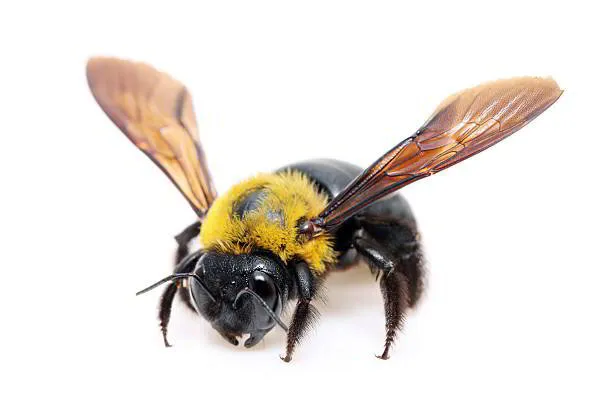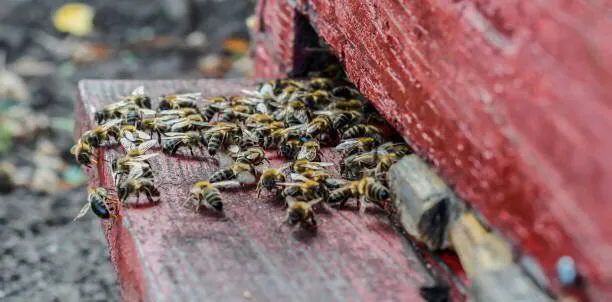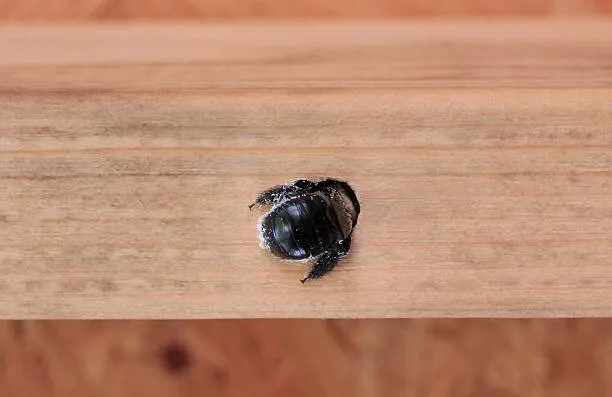What are Carpenter Bees?
The carpenter bee is a large species of stinging insect, growing to between 1/2 and 1-1/2 inch in length and, as their name suggests, they build their nests in pieces of wood. Carpenter bees have round, robust bodies that are mostly black; males may have a white or yellow face. These pests have an abdomen that is void of hair, which helps to tell them apart from a bumblebee. Female carpenter bees are docile and have a stinger, while the aggressive males have no stinger.
Are Carpenter Bees dangerous?
The venom in the stinger of a female carpenter bee is strong enough to trigger an allergic response in some people. However, they are not aggressive, and stings typically only occur if you accidentally step on one or trap them in some way. Males are very aggressive, but are unable to cause physical harm to people.
The most dangerous aspect of a carpenter bee infestation is the structural damage they cause. The female creates a hole in a piece of wood that is about the diameter of her body. She then tunnels four to six inches into the wood to create individual nesting galleries where she lays her eggs. Many carpenter bees choose the same piece of wood or area to nest in, adding to the amount of damage they can cause. Carpenter bees return year after year to the same piece of wood, eventually creating tunnels that are more than ten inches long.
Why do I have a Carpenter Bee problem?
Carpenter bees have become a problem on your property because it is offering them a place to nest near sources of food. Trees, wooden structures, and the exterior of homes are places they create their nests. Carpenter bees feed on pollen and nectar, making almost any property with gardens and flowering vegetation a place they could call home.
Where will I find Carpenter Bees?
Carpenter bees build their nests in a variety of wooden structures, preferring unfinished pieces of softwood like cedar or pine. Fences, decks, porch steps, wooden play structures, and outdoor wood furniture are common nesting sites for carpenter bees. They also build nests in wood shingles, trim, or siding located on a home or other building.
How do I get rid of Carpenter Bees?
Getting rid of carpenter bees from your yard, home, or business is best left up to a professional. The experts here at Amco Pest Solutions will provide you with the year-round solutions needed to get rid of them and prevent their return. Whether you are looking to get rid of a current infestation or prevent future problems with pests, our family-owned and operated company is here to help.
Our professionals are committed to providing the pest control services needed to keep your home or business free of carpenter bees and other common pests. Reach out to Amco Pest Solutions today to learn more about our effective home pest control and commercial pest control solutions. Let’s work together to protect your New Jersey, New York, or South Florida property from being taken over by carpenter bees!
Discover our control prevention services for more information.
How can I prevent Carpenter Bees in the future?
Seal and Paint Wooden Surfaces
Carpenter bees are attracted to exposed and untreated wood. Seal and paint wooden surfaces, including eaves, fascia boards, and decks, to make them less appealing. Ensure that the paint is thick and well-maintained to deter these insects.
Use Treated or Hardwood
Opt for treated or hardwood for outdoor structures. Carpenter bees are less likely to bore into these types of wood. Consider using naturally resistant wood species, such as cedar or redwood, for building projects.
Apply Insect Repellents
Treat wooden surfaces with insect repellents or insecticides designed to deter carpenter bees. Be sure to follow product instructions carefully and reapply as needed, especially after rain or severe weather.
Hang Carpenter Bee Traps
Install carpenter bee traps in areas where they are prevalent. These traps attract and capture the bees, helping to reduce their population around your property. Regularly empty and maintain the traps for optimal effectiveness.
Fill Existing Holes
If you notice existing carpenter bee holes, fill them with wood putty or dowels and seal the area with paint. This prevents returning bees from reusing the holes and encourages them to seek other nesting sites.
Landscaping Measures
Trim and maintain vegetation around your property, especially near wooden structures. By reducing hiding spots and creating open spaces, you make it less attractive for carpenter bees to establish nests. Regular yard maintenance can contribute to a less hospitable environment for these insects.
Carpenter Bees Exposed: Quick Insights with Amco Pest Solutions
Uncover quick insights into carpenter bees with Amco Pest Solutions. Explore the habits, risks, and effective solutions to keep these buzzing wood-borers at bay. Get quick tips on identification and proactive measures. Watch now for rapid insights into dealing with carpenter bees with Amco Pest Solutions!
Discover The World Of Carpenter Bees
Explore and learn about the ecology, diversity, and mystery of Carpenter Bees.
Our environmentally friendly control methods effectively target carpenter bees, preventing structural damage to wood on your property.
Carpenter bees create nests in wood structures. Recognizing signs of their presence is crucial for timely and effective treatment.
Preventative measures include treating or painting wood surfaces to deter nesting and sealing off exposed wood areas where possible.
What are Carpenter Bees?
The carpenter bee is a large species of stinging insect, growing to between 1/2 and 1-1/2 inch in length and, as their name suggests, they build their nests in pieces of wood. Carpenter bees have round, robust bodies that are mostly black; males may have a white or yellow face. These pests have an abdomen that is void of hair, which helps to tell them apart from a bumblebee. Female carpenter bees are docile and have a stinger, while the aggressive males have no stinger.
Are Carpenter Bees dangerous?
The venom in the stinger of a female carpenter bee is strong enough to trigger an allergic response in some people. However, they are not aggressive, and stings typically only occur if you accidentally step on one or trap them in some way. Males are very aggressive, but are unable to cause physical harm to people.
The most dangerous aspect of a carpenter bee infestation is the structural damage they cause. The female creates a hole in a piece of wood that is about the diameter of her body. She then tunnels four to six inches into the wood to create individual nesting galleries where she lays her eggs. Many carpenter bees choose the same piece of wood or area to nest in, adding to the amount of damage they can cause. Carpenter bees return year after year to the same piece of wood, eventually creating tunnels that are more than ten inches long.
Why do I have a Carpenter Bee problem?
Carpenter bees have become a problem on your property because it is offering them a place to nest near sources of food. Trees, wooden structures, and the exterior of homes are places they create their nests. Carpenter bees feed on pollen and nectar, making almost any property with gardens and flowering vegetation a place they could call home.
Where will I find Carpenter Bees?
Carpenter bees build their nests in a variety of wooden structures, preferring unfinished pieces of softwood like cedar or pine. Fences, decks, porch steps, wooden play structures, and outdoor wood furniture are common nesting sites for carpenter bees. They also build nests in wood shingles, trim, or siding located on a home or other building.
How do I get rid of Carpenter Bees?
Getting rid of carpenter bees from your yard, home, or business is best left up to a professional. The experts here at Amco Pest Solutions will provide you with the year-round solutions needed to get rid of them and prevent their return. Whether you are looking to get rid of a current infestation or prevent future problems with pests, our family-owned and operated company is here to help.
Our professionals are committed to providing the pest control services needed to keep your home or business free of carpenter bees and other common pests. Reach out to Amco Pest Solutions today to learn more about our effective home pest control and commercial pest control solutions. Let’s work together to protect your New Jersey, New York, or South Florida property from being taken over by carpenter bees!
Carpenter Bee Behavior and Adaptation
Carpenter bees exhibit unique behaviors, such as tunneling into wood to create nests, which demonstrates their adaptation to various environments. Unlike many bees, they are solitary, with each female bee constructing her own nest. These bees are also significant pollinators, transferring pollen as they feed on nectar, contributing to the health of flowering plants.
Lifecycle and Reproduction
The lifecycle of carpenter bees begins with the female laying eggs in individual chambers within wooden tunnels she excavates. Each chamber is provisioned with a mixture of pollen and nectar for the developing larvae. This solitary nesting behavior ensures the protection and nourishment of their offspring, allowing for the continuation of the species each year.
Carpenter Bees and Their Role in Ecosystems
Carpenter bees play a vital role in ecosystems as pollinators, aiding in the reproduction of many flowering plants. Their activity supports biodiversity and helps maintain healthy plant populations. While their wood-boring habits can lead to structural damage, their ecological benefits as pollinators are significant, contributing to the pollination of various crops and wild plants.
Managing Carpenter Bee Populations
Effective management of carpenter bee populations focuses on preventive measures, such as sealing exposed wood surfaces and using deterrents to discourage nesting. For existing nests, physical removal or the application of insecticidal dust may be necessary. Balancing control efforts with the preservation of their pollinating activities is crucial, highlighting the importance of non-lethal management strategies.
How can I prevent Carpenter Bees in the future?
Seal and Paint Wooden Surfaces
Carpenter bees are attracted to exposed and untreated wood. Seal and paint wooden surfaces, including eaves, fascia boards, and decks, to make them less appealing. Ensure that the paint is thick and well-maintained to deter these insects.
Use Treated or Hardwood
Opt for treated or hardwood for outdoor structures. Carpenter bees are less likely to bore into these types of wood. Consider using naturally resistant wood species, such as cedar or redwood, for building projects.
Apply Insect Repellents
Treat wooden surfaces with insect repellents or insecticides designed to deter carpenter bees. Be sure to follow product instructions carefully and reapply as needed, especially after rain or severe weather.
Hang Carpenter Bee Traps
Install carpenter bee traps in areas where they are prevalent. These traps attract and capture the bees, helping to reduce their population around your property. Regularly empty and maintain the traps for optimal effectiveness.
Fill Existing Holes
If you notice existing carpenter bee holes, fill them with wood putty or dowels and seal the area with paint. This prevents returning bees from reusing the holes and encourages them to seek other nesting sites.
Landscaping Measures
Trim and maintain vegetation around your property, especially near wooden structures. By reducing hiding spots and creating open spaces, you make it less attractive for carpenter bees to establish nests. Regular yard maintenance can contribute to a less hospitable environment for these insects.
Discover More Pests & Rodents Below!
Carpenter Bees Exposed: Quick Insights with Amco Pest Solutions
Uncover quick insights into carpenter bees with Amco Pest Solutions. Explore the habits, risks, and effective solutions to keep these buzzing wood-borers at bay. Get quick tips on identification and proactive measures. Watch now for rapid insights into dealing with carpenter bees with Amco Pest Solutions!



